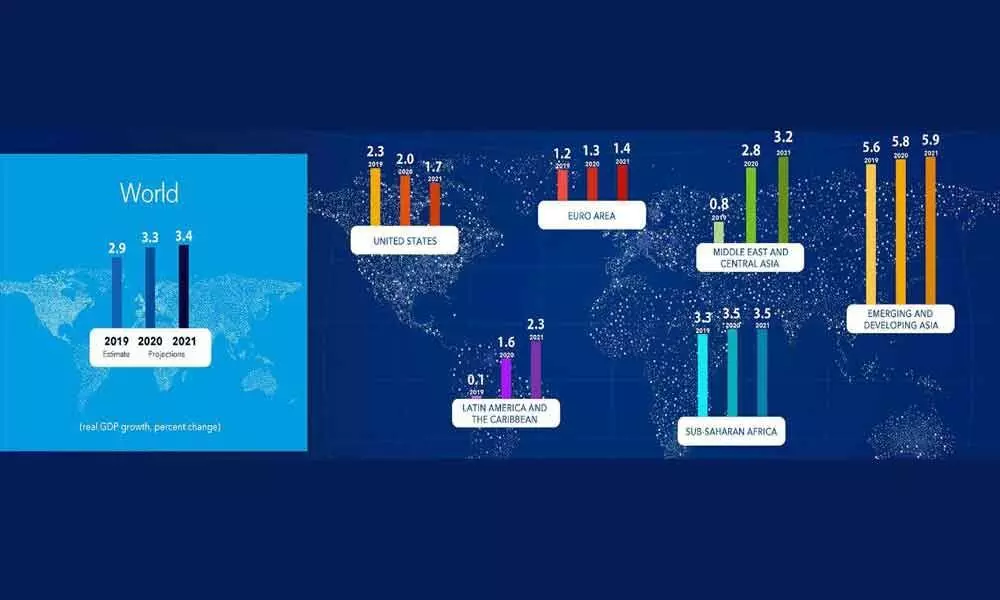IMF cuts India's Growth Forecasts to 4.8% for 2019; Also slashes Global forecasts

The International Monetary Fund (IMF) on Monday lowered its growth estimate for India to 4.8 per cent for 2019 from 6.1 per cent expansion that it projected in October 2019. The projections were slashed citing stress in the non-bank financial sector and weak rural income growth as the major factors for the downward revision.
The International Monetary Fund (IMF) on Monday lowered its growth estimate for India to 4.8 per cent for 2019 from 6.1 per cent expansion that it projected in October 2019. The projections were slashed citing stress in the non-bank financial sector and weak rural income growth as the major factors for the downward revision.
The IMF's World Economic Outlook, January 2020 says Global growth is projected to rise from an estimated 2.9 per cent in 2019 to 3.3 per cent in 2020 and 3.4 per cent for 2021. Estimates for 2019 and 2020 were cut by 0.1 percentage point from forecasts made in October while the estimates for 2021 has been slashed by 0.2 percentage point.
The downward revision primarily reflects negative surprises to economic activity in a few emerging market economies, notably India, which led to a reassessment of growth prospects over the next two years. In a few cases, this reassessment also reflects the impact of increased social unrest.
The IMF also said it marked down growth forecasts for Chile due to social unrest and Mexico, due to continued weakness in investment.
But it said a US-China trade deal was another sign that trade and manufacturing activity may soon bottom out. In its release, the fund said that easing of tensions between the United States and China, which had stunted GDP growth in 2019, had boosted the market sentiment, amid tentative signs that trade ad manufacturing was bottoming out.
It says, "These early signs of stabilization could persist and eventually reinforce the link between still-resilient consumer spending and improved business spending". It added, "Additional support could come from fading idiosyncratic drags in key emerging markets coupled with the effects of monetary easing".
Downside risks, however, remain prominent, including rising geopolitical tensions, notably between the United States and Iran, intensifying social unrest, further worsening of relations between the United States and its trading partners, and deepening economic frictions between other countries. A materialization of these risks could lead to rapidly deteriorating sentiment, causing global growth to fall below the projected baseline.
Projection for other countries
United States: The US growth is expected to moderate from 2.3 per cent in 2019 to 2 per cent in 2020 and decline further to 1.7 per cent in 2021. The moderation reflects a return to a neutral fiscal stance and anticipated waning support from the further loosening of financial conditions.
Eurozone: Growth projection for Eurozone is projected to pick up from 1.2 per cent in 2019 to 1.3 per cent in 2020 - a downward revision of 0.1 percentage point - and 1.4 per cent in 2021. Projected improvements in external demand support the anticipated firming of growth. The projections have been marked down for 2020 in Germany, where manufacturing activity remains in contractionary territory in late 2019, and for Spain due to carryover from the stronger-than-expected deceleration in domestic demand and exports in 2019. However, the October 2019 WEO projections for France and Italy remain unchanged.
The United Kingdom: Growth is expected to stabilize at 1.4 per cent in 2020 and firm up to 1.5 per cent in 2021—unchanged from the October WEO. The growth forecast assumes an orderly exit from the European Union at the end of January followed by a gradual transition to a new economic relationship.
Japan: Growth rate is projected to moderate from an estimated 1 per cent in 2019 to 0.7 per cent in 2020 - 0.1 and 0.2 percentage point higher than in the October WEO. The upward revision to estimated 2019 growth reflects healthy private consumption, supported in part by government countermeasures that accompanied the October increase in the consumption tax rate, robust capital expenditure, and historical revisions to national accounts. Growth is expected to decline to 0.5 per cent (close to potential) in 2021, as the impact of fiscal stimulus fades.
Emerging and developing Asia: IMF in its forecast for Asia says, growth in emerging and developing Asia will inch up slightly from 5.6 per cent in 2019 to 5.8 per cent in 2020 and 5.0per cent in 2021. The growth markdown largely reflects a downward revision to India's projection, where domestic demand has slowed more sharply than expected amid stress in the nonbank financial sector and a decline in credit growth.
India: India's growth is estimated at 4.8 per cent in 2019, projected to improve to 5.8 per cent in 2020 and 6.5 per cent in 2021. This growth will be supported by the monetary and fiscal stimulus as well as subdued oil prices.
China: IMF has upgraded China's 2020 growth forecast by 0.2 percentage point to 6 per cent and 5.8 per cent in 2021. The forecast is backed by the US trade deal that includes partial tariff reduction and cancelled tariffs on Chinese consumer goods.


















